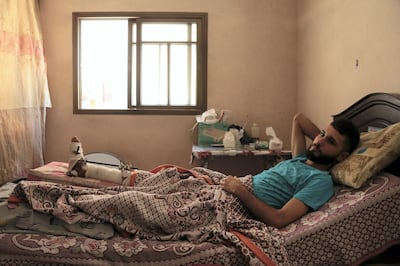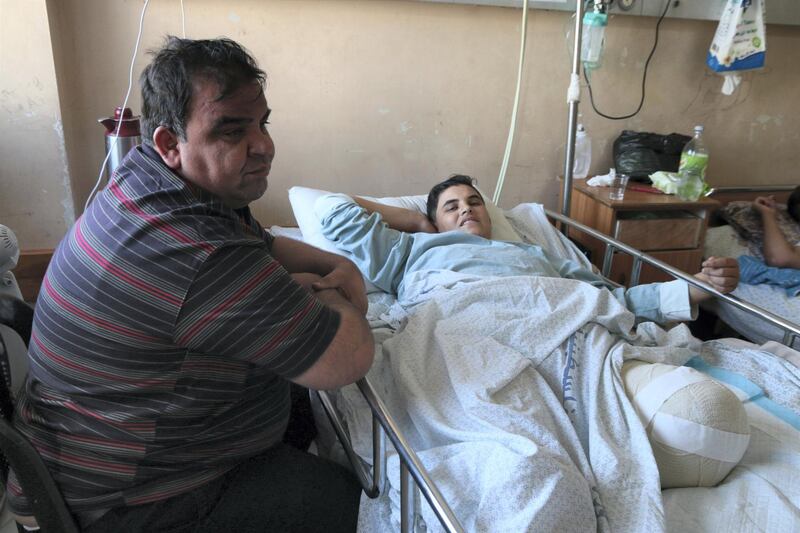Over a month after the bullet pierced his right leg, Abdallah Derwish is still battling to save his devastated limb.
The 22-year-old was felled by an Israeli sniper round on March 30, the first day of mass protests on the border fences of the Gaza Strip. Called the Great March of Return, the rallies were to protest the expulsion of the Arab population from what became Israeli territory in 1948 and to demand their return.
The demonstrations have settled into a weekly cycle of Friday protests that have suffered a heavy toll as Israeli troops opened fire on the crowds. So far, 123 protesters have been killed, and over 14,000 wounded, according to Palestinian hospital staff.
This exceeds the number of injured that flooded into Gaza's hospitals in the 2014 war with Israel, overwhelming a system already smarting from an eleven year-long economic blockade of the enclave. Doctors say the enclave’s medical facilities are at breaking point, leaving hundreds of victims without treatment.
“The health system was on the verge of collapse before the Great March of Return,” Dr Ayman Sahabani, head of the emergency unit at Al Shifa Hospital, Gaza’s largest medical facility, told The National.
Along a dimly lit corridor, doors open to rooms where gunshot victims lie on creaking, rusty bed frames. There is little medical equipment, even drips are rare. Nurses and and doctors are seldom seen, but family members further crowd the rooms and provide patients with some creature comforts.
Hospitals like Al Shifa are forced into a grim weekly routine, as they discharge heavily wounded gunshot victims ahead of Friday protests and the inevitable round of new arrivals.
"We discharge many patients early because we haven't got enough beds. All of them should stay in hospital. They need recurrent operations, and months if not years of treatment. Most of them come back within days with infections," Dr Sahabani said.
Half of the sixty-four gunshot victims recuperating in Al Shifa could be discharged prematurely by Friday morning, the doctor says. Early releases impede the recovery process of patients, and Dr Sahabani estimates that half of those gunshot victims will be disabled for the rest of their lives. Most of them are young men.
_______________
Read more:
Israel and Gaza exchange fire after Palestinian woman killed at border
Israel to cut Palestinian funds over arson damage
US vetoes Kuwait UN proposal to protect Palestinians
_______________
Mr Derwish, who was admitted to the Indonesia Hospital, the medical facility built on a hilltop outside Jabalia, Gaza’s largest refugee camp, was also hastily discharged only eight days after he was shot.
"The entire hospital was emptied on Friday morning," he remembers.
He was allowed to come back to the hospital two days later before being transferred to Al Shifa for an operation. He now lies in his bed at home. His right leg is heavily bandaged and steadied by a metal frame that holds together his shattered bones. The snipers on the other side of the fence are frequently targeting the lower limbs of protesters with ammunition that explodes on impact. These rounds are far more destructive than normal bullets, devastating bones, severing nerves and arteries, and tearing gaping exit wounds.
Mr Derwish, a student of Quds Open University is worried that he will lose his shredded leg, but he and his family decided that it would be better to care for him at home than to keep him in the dilapidated hospital.
"We prefer staying here and taking care of him. Most of the amputations are because the doctors are careless. The staff is under pressure and very stressed," says his older brother Abdelhamid. Medics from a Turkish NGO come to the house in Gaza City’s shabby Jabalia neighbourhood to change his bandages every two days. Abdelhamid, who works in a laboratory, administers a drip and other medication when needed.
Not everyone discharged from hospital earlier than necessary has been lucky enough to survive. Mohammed Hamada, who was shot in the leg on May 14, died on June 2 after his wound became infected following his premature release from Al Shifa hospital.

The devastation wrought by explosive bullets is such that a coveted space in a hospital ward does not guarantee a successful recovery. Bashir Faraj, a 22-year-old mathematics student, was shot in the leg on May 14, the day that the opening of the US embassy in Jerusalem brought thousands of Palestinian protesters to the Gaza border and the bloodiest of the weekly rallies. At least 60 people were killed, including several minors, and around 3,000 injured from bullets and tear gas.
Mr Faraj was delivered to the emergency ward after his shooting. But he also needed treatment for a heart attack, so the wound was neglected until an amputation became unavoidable, according to his father Mohammed.
“This hospital is very crowded. The amputation should have been performed at 9am, but it was done at 4:30pm,” says the father, who sits next to his son's bed with worry etched on this face.
The student shares a dingy room with two other protesters. The stump of his right leg ends in a thick lump of white bandage. As the pain spasms through his body, he grimasses, groans, and bites his blanket. With the protests continuing, he might soon be sent home as early as Friday to make room for new arrivals.
In the bed next to him, 20-year-old Amro Haddad is still clinging on to hope. The skin on Mr Haddad's wounded leg has already turned yellow, his toes dark purple. But his family hope to have his wound treated abroad. They have applied for an exit permit for the Rafah border crossing to Egypt. Like Israel, Egypt controls access in and out of a Gaza crossing in response to Hamas winning elections in the exclave in 2006. It has opened Rafah over Ramadan, but a huge backlog of applications mean that the chances of a swift exit are slim.
Tight exit restrictions for Gazans mean that dozens of people in need of critical treatment die every year even if there are no major hostilities, Dr Sahabani says.
With the wards still packed, the head of the emergency ward despairs when he thinks ahead to this Friday's protests. The organisers are changing tack. While the Great March of Return commemorated the expulsion of Palestinians, Friday's protests are a reminder of the occupation of Gaza and the West Bank by Israeli forces during the 1967 Arab-Israeli War. This is likely to give renewed impetus to the demonstrations, which raises the spectre of another wave of maimed protesters.
"If we receive patients on Friday I don't know how to deal with them. A lot of them will die. We have thousands of injured people in the hospital that we can't discharge. We haven't got enough beds or medical supplies,” the doctor says.
“How are we to deal with this?”





